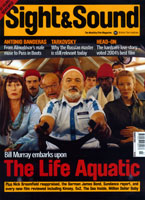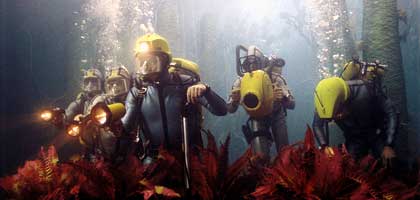
Lesser Spotted Fish And Other Stories...


Wes Anderson's latest offbeat ensemble comedy The Life Aquatic plays like 8 1/2 made by Jacques Cousteau. The director talks to Kevin Conroy Scott.
Last September as I ran through Manhattan's midtown, afraid I might be late for a 'friends-only' preview of Wes Anderson's The Life Aquatic with Steve Zissou, the remnants of Hurricane Francis were clothing the city in an oppressive humidity. Anderson had invited me over from London to interview him for the published screenplay, co-written with a new scripting partner, writer-director Noah Baumbach, and I leaped at the offer. At 53rd and 5th, snaking my way through the lunchtime swarm, I spotted Anderson striding along, wearing a cream linen suit and blue retro Nikes. His manner - casual, friendly, intelligent, inquisitive - remained the same as from our first meeting in February 2002, just after he was nominated for a Best Original Screenplay Oscar for The Royal Tenenbaums, but his hair was now long and he'd replaced his horn-rimmed glasses with contact lenses. He looked less like the kid who has all the answers and more like a man Fellini might have made a movie about.
Anderson's directorial debut was Bottle Rocket (1995), a crackpot comedy crime caper about a trio of Houston layabouts. It still feels handmade and rough around the edges, but its dry wit and sensitivity towards its characters shine through. At the end of the film, when the heist has gone wrong, the ringleader Didgnan (played by Anderson's long-time collaborator and university friend Owen Wilson) offers to go back to save an injured member of the 'gang', insisting, "They'll never catch me, man, 'cause I'm fuckin' innocent." It's a moment that Martin Scorsese - who once called Anderson "the next Martin Scorsese" - described as "transcendent". Didgnan may not be innocent of the crime, but he's a true innocent as a person.
Anderson told me that he and Wilson, Bottle Rocket's co-writer, had set out to make a gritty crime drama about coming of age, their own version of Mean Streets (1973). "BottleRocket came from how our lives were. If you take the guns and the crime element out then it was more or less our lifestyle at the time." Located in swimming pools, country clubs and suburban houses, Bottle Rocket makes it clear that Anderson's experiences of growing up were miles away from those of Scorsese, the asthmatic kid in the window, watching life's dirty dramas play out on the streets of Little Italy.
As Anderson's career progressed, he moved from the small, quirky and personal to a more robust and fully realised cinema packed with the flotsam and jetsam that inspires him. For his second film Rushmore (1998) he created an alternative universe inside a private school, shooting the film at the school he himself attended. In The Royal Tenenbaums (2001) he went further, refashioning New York City as a parallel world and giving full rein to his teenage obsession with the New Yorker magazine (he used to check copies out from the library and compiled a file of clippings by his favourite journalists, such as Lilian Ross, now a friend).
Connected to Fellini
The Life Aquatic with Steve Zissou , Anderson's fourth feature, is a sea-faring action-adventure-comedy about an over-the-hill oceanographer who makes hokey, action-packed documentaries. When I read the screenplay before I flew to New York, the first thing I noticed was that 18 characters are introduced in the first ten pages as we learn about Zissou and his team. This being a Wes Anderson film, these characters have names like Esteban du Plantier, Vladamir Wolodarsky and Oseary Drakoulias (the film-within-the-film's producer, as you might guess from the vampire permutation). Anderson has a fetish for literary touches and here it's as if he's taken the characters from such novels as The Great Gatsby and The Magnificent Ambersons, swapped the first names of some with the surnames of others and presented them as his own creations in a front-room picture show. Some might object to such borrowings, but Anderson invariably makes the right choices.
The plot of The Life Aquatic revolves around the Jacques Cousteau-like film-maker Zissou (played by a quietly brooding Bill Murray), who has just lost his trusted cameraman to a huge 'jaguar shark'. Asked by a member of an Italian film-festival audience in the opening sequence for his scientific justification for hunting down the great fish he claims has swallowed his friend, Zissou offers one word: "revenge". The quest also gives him the opportunity to make another film, and The Life Aquatic chronicles his struggles to keep the show on an even keel and to support his team of misfits. When Southern-gentleman airline pilot Ned Plimpton (played by a dapper Wilson, sporting a moustache) arrives claiming to be Zissou's long-lost son, the film-maker invites him and his life savings on board, providing himself with the funds to make the movie as well as a "relationship subplot".
I asked Anderson where the idea for The Life Aquatic came from. "About 15 years ago I wrote the first page of the short story the film is based on," he said. "It was inspired by watching Jacques Cousteau films, and Owen Wilson was always suggesting I should try to expand it or that it should be a movie."
The film was shot on Fellini's home turf at the Cinecittà studios near Rome and in the harbours of Italy. It shares its film-within-a-film structure with 8 1 / 2 (1963), along with its depiction of the lonely helmsman's problems of finding inspiration and finance and grappling with an overweight producer. But while Murray's Zissou has something of the melancholy of 8 1 / 2's Fellini alter ego Guido Anselmi (Marcello Mastroianni), Anderson focuses less on the depressed ringmaster/director than on the set-up of a dysfunctional family of eccentrics headed by a selfish asshole of a father (a premise that sounds reminiscent of The Royal Tenenbaums). "Zissou is at the centre of a group of people who are swirling around him and he's got to invent something for them to do. But the character is more about the people I've been with when I've been making movies than about me," says Anderson. "And of course 8 1 / 2 is something Noah Baumbach and I talked about - it's a movie we love. Working in Cinecittà, I felt connected to Fellini, and we definitely took inspiration from him."
The crew are provided with an acoustic soundtrack by Team Zissou member Seu Jorge (Knockout Ned from Brazilian blockbuster City of God), who sings cover versions of David Bowie songs. "I saw Seu in City of God," says Anderson, "but then it turned out that he is a pop star in his native country. He adapted the songs himself, making them sound Brazilian, and translated them into Portuguese." (Bowie, who granted permission, likes the new versions.) The songs convey the melancholy, humorous, otherworldly atmosphere of the film - the Wes Anderson signature.
Cooking up sneakers
During the frenzied action of the first robbery in Bottle Rocket one of the characters pauses to place a toy soldier back in its rightful position before moving on. And for Anderson too it often seems it's how things are arranged rather than the drama that's important. His obsessive attention to detail is played out not only in his formal compositions but in the way he builds his alternative universes, with an information overload that charms the viewer into submission. But if a film like The Royal Tenenbaums is filled with embroidered detail, with the characters' whole backstories presented in long digressions, then The Life Aquatic is an embroidery on an embroidery.
Here a large ship named the Belafonte, populated by people in designer scuba gear, visits a world of underwater forests and a forgotten island with a dilapidated pleasure palace. In his quest for perfection, Anderson even fashioned the Adidas trainers Zissou and his team wear. "I was trying to cook up a good sneaker," he says. "I like the idea that this character, who's supposed to be a scientist, spends a lot of his time making his team look cool. With The Royal Tenenbaums I worried that I controlled things too much so with this movie I tried to keep it freer. But there are still millions of things that we invented and millions of choices we made."
For the Belafonte Anderson and his production designer Mark Friedberg needed two identical ships: one for the ocean-faring sequences and the other to be bisected and placed on a sound stage for the bravura crane shot that introduces the internal workings of Zissou's home from home. "There was no stage big enough at Cinecittà to hold the boat," Anderson says. "We used Stage 5, Fellini's stage, but you couldn't get far enough back to get a shot of the whole ship. It was almost five stories tall and it became a local talking point."
When I first interviewed Anderson in 2002, just after he'd submitted the script for The Life Aquatic to Disney, his West Village office was crowded with oceanographers' journals and maps, with a cross-section of a ship above the sofa. As he told me more about the forthcoming project I warned him of what Spielberg's screenwriter on Jaws said about making movies on water: "Don't do it. It's too much trouble. Too many variables you can't control." Anderson, in his best Andy Warhol gee-whiz accent, replied: "I guess I should have read that remark before deciding to make this movie."
Two years on we met at an Italian restaurant nearby, where he sat beneath a large photograph of the city of Florence, the Uffizi gallery over one shoulder and the Duomo over the other. Naturally, I asked him if he regretted the decision. "What was most difficult was striking a balance between what was real and what was fake. There was even talk of not filming underwater at all but just cheating instead. My DoP and I watched every relevant movie we could and the one we fixed on was The Black Stallion, from 1979. There the exteriors at the beginning of the film are on a real ship but the subsequent interior scenes do nothing to communicate that - there's just one shot where the camera sways as if it were at sea. So we put in one shot too and that was it. Once the audience knows you're on the ship you don't have to do anything else."
Anderson and his DoP also sampled the James Cameron cookbook of underwater film-making provided by the DVD commentary for The Abyss. "He tells you all his tricks: 'This shot was done with a one-quarter-sized model. This shot was done with a three-quarter-sized model.' Every shot uses a different technique and he gives you the recipe."
As we left his favourite restaurant Anderson picked up the tab, signing his account while the waiter made a joke about being a star in his next movie. The sweltering closeness of Hurricane Francis was subsiding, but the hermetic world of The Life Aquatic remained fresh in my mind.
